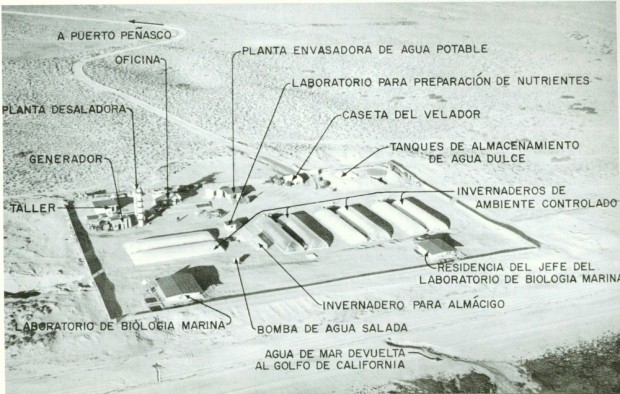Contributor: Steve Schwab

Since the early 1960’s, University of Arizona scientist Carl Hodges had capitalized on the potential for agricultural research that the fertile and vibrant area of Puerto Peñasco, Mexico had to offer. With its close proximity to the U of A and the immediate, desert-like conditions, Rocky Point was the perfect choice for Hodges’ ambitious new research. The professor had been working on ways of providing coastal areas with limited access to fresh water a source of desalinated, potable water. In 1964, under the direction of Dr. Hodges, the University of Arizona and the University of Sonora teamed up to build a desalination plant in Puerto Peñasco, Mexico. Scientists from Mexico and the United States constructed the plant, with the emphasis on self- sufficiency and utilizing solar power for the desalination process.
While the solar desalination process created by the scientists was successful, it was clear from the very beginning that the process would not be able to adequately provide the demands for fresh water that the already burgeoning population of Puerto Peñasco required. According to author Guillermo Munro Palacio in A Brief History of Puerto Peñasco, the plant located just outside of Puerto Peñasco was only able to produce between six and eight thousand gallons of fresh water per day. With the thirsty inhabitants (by this time estimated to be at five thousand) requiring at least twenty five to thirty gallons per day, the output of the plant equaled about two gallons per person, per day.

Still, Hodges wasn’t done with this ambitious project, and pressed on, discovering ways of producing viable food sources in desert conditions. In the greenhouses of the research facility he grew fruit trees and vegetables, watered with a steady reciprocal drip system from the desalination process he had developed. The facility remained operational, and in the late 1970’s the Coca-Cola Company began funding the research being conducted at the site. The soft drink company was most interested in the hybrid shrimp that the scientists were raising in the moderately synthetic environment.
It’s hard to tell what really happened next, but it is safe to say; when you mix salt water and Coca-Cola with a shrimp cocktail, you have all the fixings for some really weird science. By the late 1970’s, all was not well with investors, scientists and the strange gated research facility on the edge of town. By July of 1978, the diverse investment portfolio of the Coca-Cola Company began to raise the interest of the financial community, and often the ire of investors. The company was already highly criticized for investing over a million dollars in a failed Broadway play titled “1600 Pennsylvania Avenue.” Inquiries into the mysterious desert facilities and the company’s interests in aquaculture were called into question. The company did little to dispel the mystery surrounding their involvement in the research facility, telling a reporter in 1978 that the research was being done “under plastic bubbles,” conjuring images of groovy 70’s space-age “bio-domes.”
Whatever was going on inside the research facility; it all came to a head in 1980, as the US headlines were awash in tales of a Mexican military takeover at the plant, and U of A scientists fleeing for their lives. It was the perfect scenario for any low grade B movie with great music and bad monsters; mad scientists breeding mutant shrimp, the genetically altered creature can no longer be contained in the tiny lab on the outskirts of Rocky Point.
Unfortunately, the real story wasn’t nearly as interesting, although it did become just as weird and whacky…
